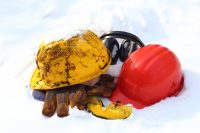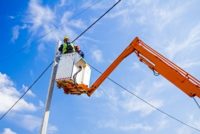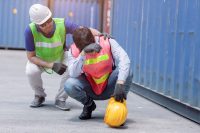Category: Special Topics in Safety Management
Safety is a process, and as such, needs to be managed. This section offers resources to create a viable safety program, sell it to senior management, train supervisors and employees in using it, and then track and report your progress. Look also for ways to advance your own skills in these areas, both for your current job, and those that follow.
The winter season is upon us once again, and with the colder weather come a unique set of hazards that can cause injuries and illness among the workforce. Here are some tips for protecting your employees from cold stress, frostbite, and hypothermia.
With winter weather comes the potential for severe storms—and the aftermath may include the necessity for utility repair work and/or tree removal. Aerial lifts are often employed in these purposes, and one Safety.BLR.com subscriber wanted to know what the fall protection requirements are for this machinery. Read on to see what the experts had to […]
Have you become complacent about safety hazards like falls while focusing on the health hazards of the COVID-19 pandemic? The consequences may be tragic—falls from height are one of the “Fatal Four” safety hazards, along with caught-in or -between, electrocution, and struck-by hazards—and failure to comply with fall protection regulations can result in citations and […]
ASTM International, a standards-setting organization formerly known as The American Society for Testing and Materials, is developing a new specification for face coverings. The Centers for Disease Control and Prevention (CDC) has recommended cloth face coverings for the general public to reduce the number of COVID-19 cases, the Occupational Safety and Health Administration (OSHA) has […]
Filtering facepiece respirators (FFRs) with exhalation valves, as well as a surgical mask or an unregulated face covering, can reduce a wearer’s aerosol emissions, according to a report released on December 9 by the National Institute for Occupational Safety and Health (NIOSH). With modifications, the respirators can offer the same level of source control as […]
Your safety culture—the attitudes and habits underlying health and safety practices and compliance programs in your workplace—is an essential hazard control. It can be difficult to build but easy to destroy, and one thing that can destroy your carefully constructed safety culture is a permissive attitude toward the safety practices of your contractors and suppliers.
The Centers for Disease Control and Prevention (CDC) awarded $1.5 million in funding over 3 years for research into reducing workers’ exposures to hazards through the development and use of collaborative robots, or co-robots, to be performed by the University of Illinois at Chicago and Worcester Polytechnic Institute, the CDC announced.
The Occupational Safety and Health Administration (OSHA) does not consider cloth face coverings personal protective equipment (PPE), the agency said on November 18 in an update to its frequently asked questions (FAQs) about coronavirus disease 2019 (COVID-19).
Worker fatigue poses a clear and present danger to the workforce, but how many environment, health, and safety (EHS) teams have a plan in place to mitigate the risk? It’s important to understand the hazards and put a preventive action plan in place at your organization.
Thanksgiving is right around the corner, and health and safety are at top of mind now more than ever. To say that 2020 has been an unusual year is the understatement of…well, the year, and there are some new hazards joining the more common ones that face us every holiday season.









